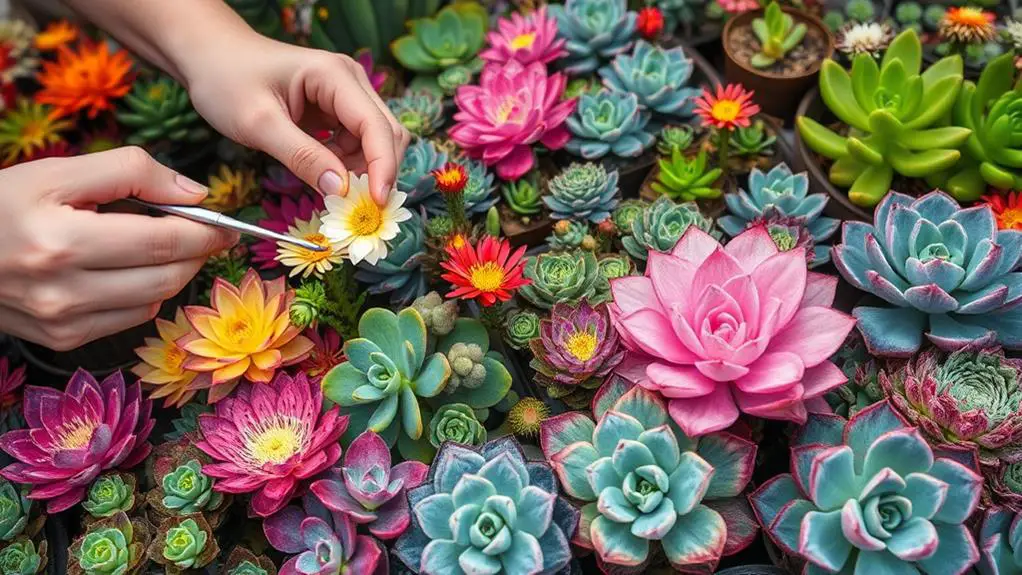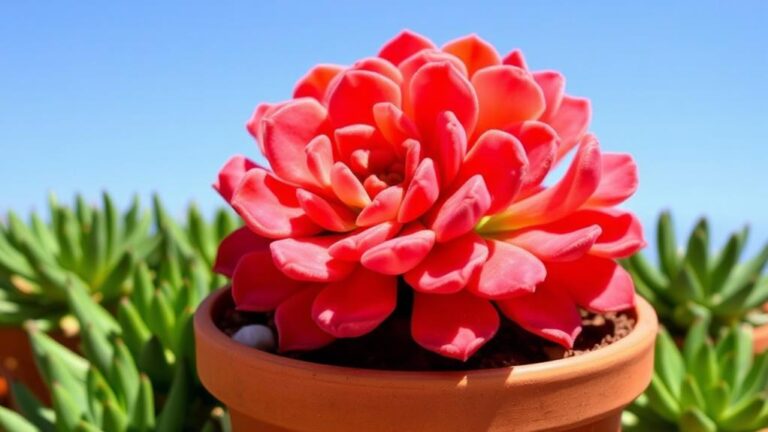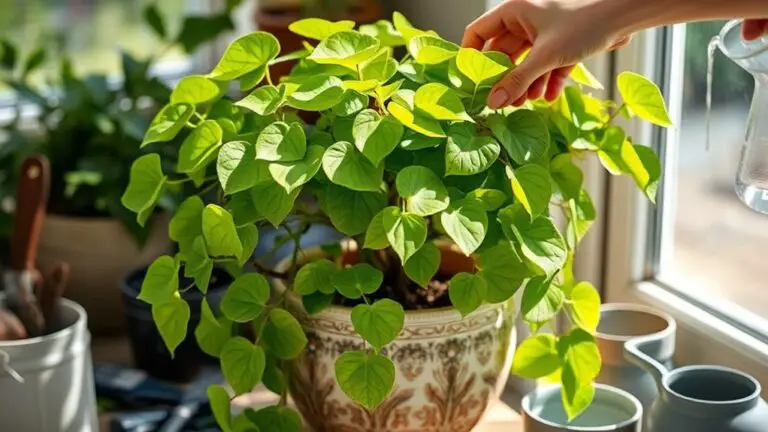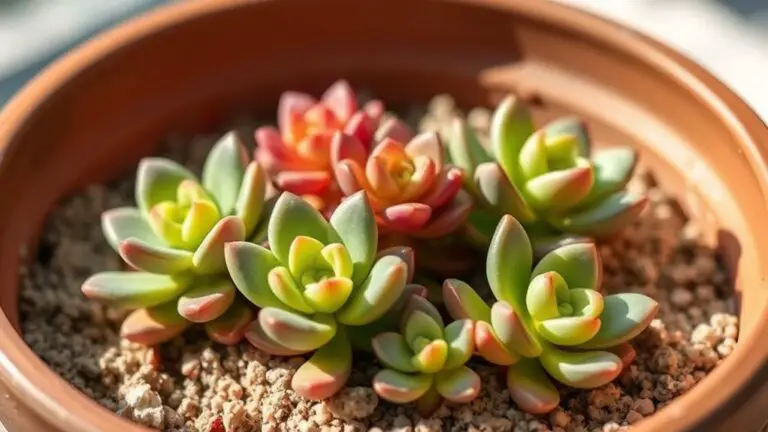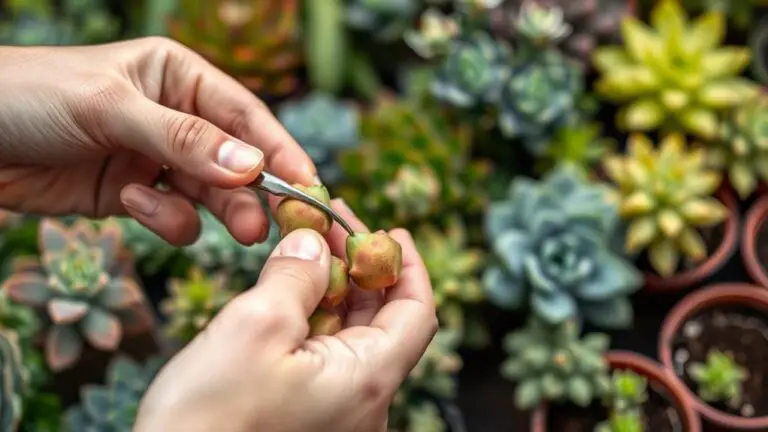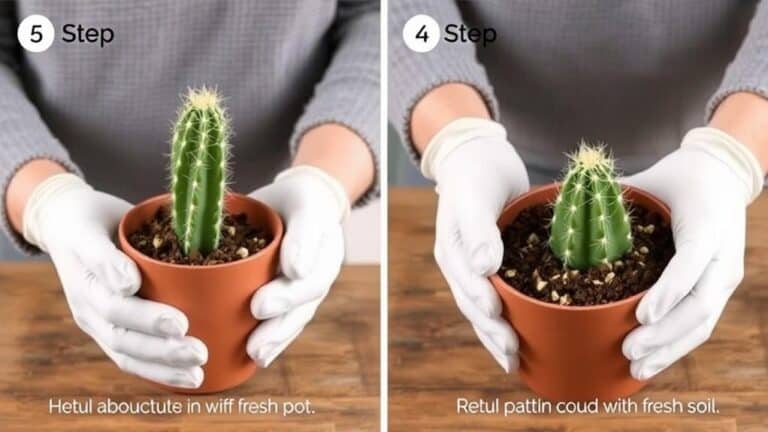All You Need to Know: Creating Succulent Hybrids
When you start creating succulent hybrids, you're stepping into a world where patience meets creativity. By cross-pollinating different species, you can develop unique plants that showcase traits neither parent possesses. It's a meticulous process requiring healthy, flowering succulents and careful handling of pollen. But what happens after you've successfully pollinated? How do you guarantee your new hybrid thrives and displays its full potential? There are key steps and common pitfalls you'll need to navigate, but the reward is a truly one-of-a-kind plant. Curious about the intricate journey from pollination to flourishing hybrid?
What Are Hybrid Succulents?
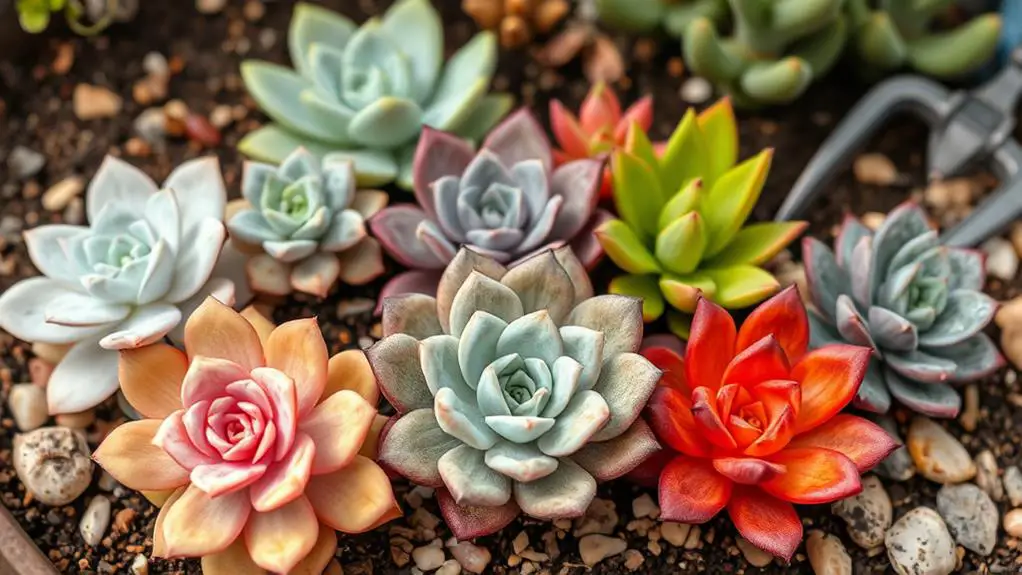
Hybrid succulents are fascinating plants created by cross-breeding two different succulent species through cross-pollination. This process results in new species of succulent that possess unique traits not found in their parent species. Imagine combining the best features of two plants to create something entirely new and beautiful. The hybridization process truly showcases the magic of nature.
When hybrid succulents are formed, they often display a combination of colors, shapes, and growth patterns from their parent plants. For example, you might get a succulent with the vibrant color of one parent and the resilient nature of another.
Popular hybrids like Echeveria, Graptosedum, and Gasteraloe each highlight distinct characteristics from their parent species, making them unique and desirable for any garden.
Naming these hybrids can be fun and creative. Sometimes, you combine the names of the parent species, or you might invent a new name that reflects the plant's identity. It's like naming a new friend!
However, patience is essential because the success of cross-pollinating and creating a new hybrid is often only evident after the plant matures. So, enjoy the journey and watch your hybrid succulents grow into something extraordinary.
Creating a Hybrid Succulent
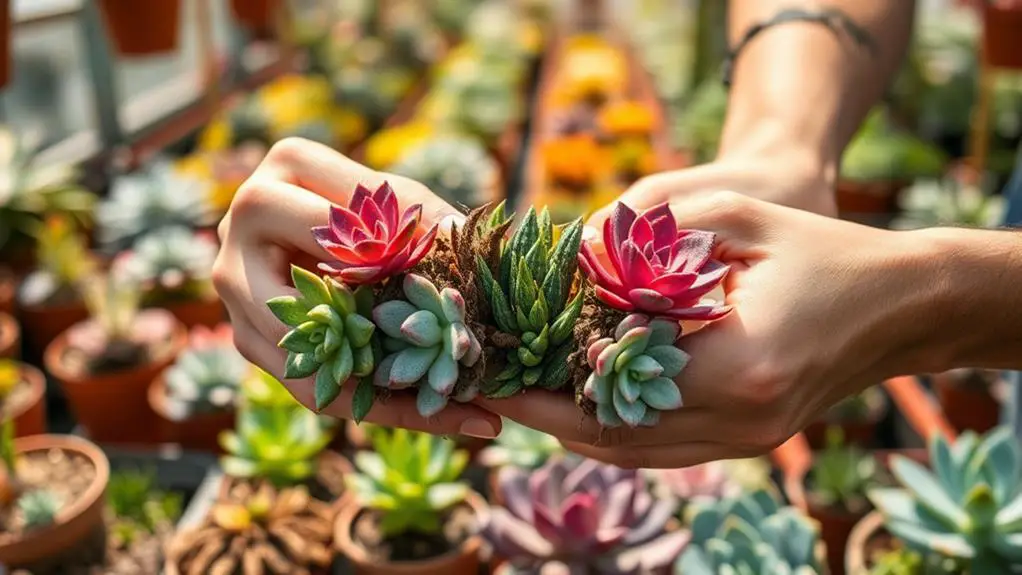
Creating a hybrid succulent starts with selecting at least two flowering succulents, ideally from the same genus for higher success rates.
You'll need to choose two plants that are healthy and flowering. To create a hybrid, begin by cross-pollinating the succulents. Use a soft paintbrush or a Q-tip to gently collect pollen from the stamens of one succulent. Carefully transfer it to the stigma of another succulent's flower. Be sure you handle the flowers gently to avoid contamination.
After you've pollinated the flower, monitor it closely. Look for swelling at the base of the flower, which indicates successful fertilization and the potential for seed development.
During this period, it's essential to isolate the pollinated plant to prevent unwanted cross-pollination from other succulents nearby.
Once the seeds have developed and matured, you can plant them in well-draining soil. This helps guarantee that your new hybrid has the best chance to grow strong and healthy.
As the plant matures, you can name your hybrid by combining the names of the parent plants or coming up with a creative name that reflects its unique characteristics.
Enjoy the process and the beautiful results!
Popular Hybrid Succulents
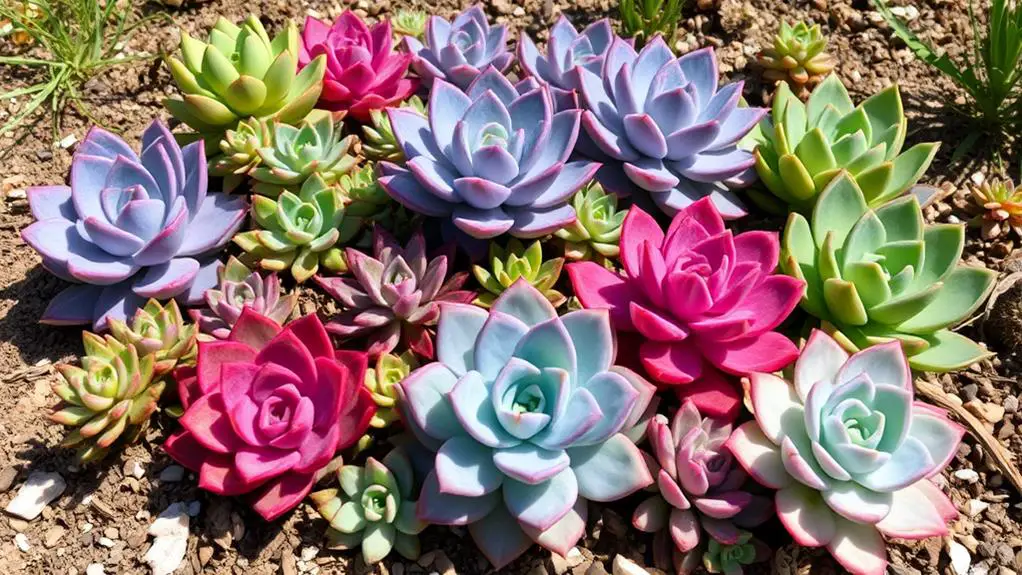
Delving into the world of hybrid succulents, you'll find a treasure trove of unique and vibrant plants that capture the imagination of gardeners and enthusiasts alike. Understanding the existence of hybrids like Echeveria is essential, as these often end in "veria" and showcase diverse colors and forms.
One standout is the Graptosedum, created by cross-pollinating Graptopetalum and Sedum. It's celebrated for its vibrant colors and ease of propagation. The California Sunset variety, with its stunning hues, is a favorite among many.
Sedeveria, another popular hybrid, combines Sedum and Echeveria. Its compact growth habit and various color variations make it a must-have. You'll appreciate its resilience and beauty in any garden.
Gasteraloe, merging Aloe and Gasteria, is known for striking leaf patterns. Varieties like Gasteria Flow Spiky Aloe are unique and eye-catching, perfect for adding a touch of intrigue to your collection.
Graptoveria, a blend of Graptopetalum and Echeveria, offers interesting forms and colors. Popular examples include Graptoveria Opalina and Graptoveria Bashful, both showcasing the best traits of their parent species.
Exploring these hybrids involves cross-pollinating different species, resulting in an array of exciting and beautiful plants.
Common Hybridization Problems
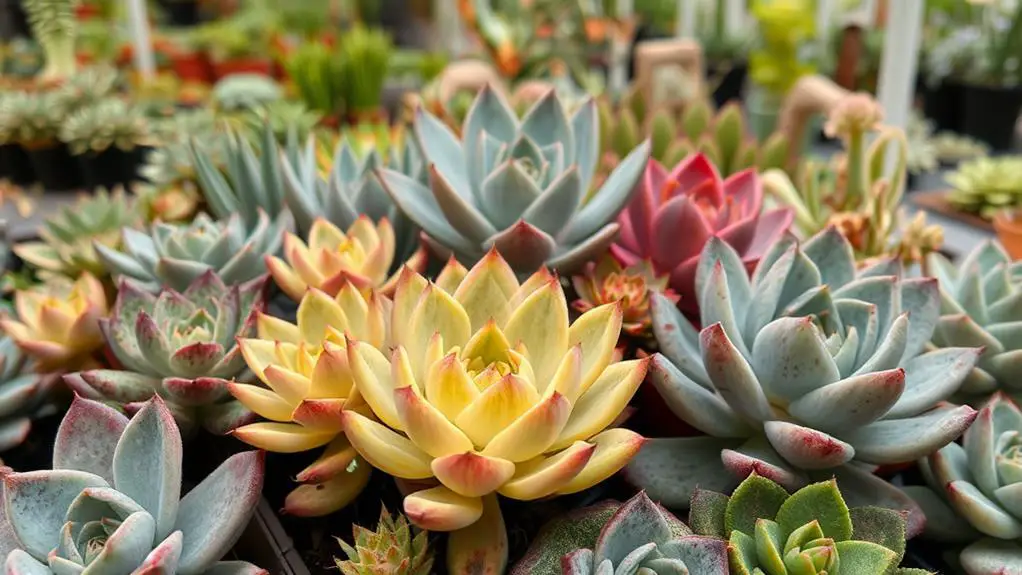
Creating succulent hybrids can be a test of patience, as you might wait weeks or even months to see results after pollination.
These hybrids often show sensitivity to their environment, requiring you to monitor light and handling closely to keep them healthy.
Patience and Time
Hybridizing succulents demands a great deal of patience and time, often stretching across weeks or even months before any noticeable results appear.
You need to embrace this process with patience, as the unpredictability of hybrid outcomes means your new plants mightn't look like their parents. This can be disappointing, but it's part of the journey.
First, remember that hybridization might fail entirely on your first few tries. Don't get discouraged. Multiple attempts are often necessary to achieve the desired results.
Care tips can help, but it's also about persistence and learning from each try. Your hybrids can be crazy sensitive to light and handling, so careful monitoring is essential.
Time to fully understand your plants' needs is necessary. Environmental conditions play a big role in your success.
Adaptability in care strategies can make all the difference. Pay close attention to their responses to different light levels, water schedules, and temperatures.
Be patient and flexible. Each attempt teaches you something new.
With dedication, you'll eventually see the rewards of your efforts. Keep going, and remember, every step, even the setbacks, brings you closer to creating unique and beautiful succulent hybrids.
Hybrid Sensitivity
When dealing with hybrid sensitivity, you'll quickly notice that hybrid succulents often require extra attention compared to their parent plants.
These hybrids can be more sensitive to light, so you need to carefully acclimatize them to prevent sunburn or stress. Start by gradually introducing them to brighter light and monitor their reaction closely.
Handling hybrid succulents gently is vital because they can be more delicate and prone to damage.
Always use care during routine tasks like repotting or even simple watering.
Environmental conditions, such as humidity and temperature fluctuations, can greatly impact their health and growth.
Confirm your hybrid succulents are placed in a stable environment where these factors are controlled as much as possible.
Monitoring soil moisture is essential.
Unlike their parent species, hybrids may have different watering needs. Overwatering can lead to root rot, so it's important to check the soil regularly.
Use a moisture meter or simply feel the soil to determine when it needs water.
Understanding each hybrid's specific requirements is key.
Their unpredictable traits mean you might face unexpected care challenges, but with careful attention and patience, you can help your hybrid succulents thrive.
Care for Hybrid Succulents
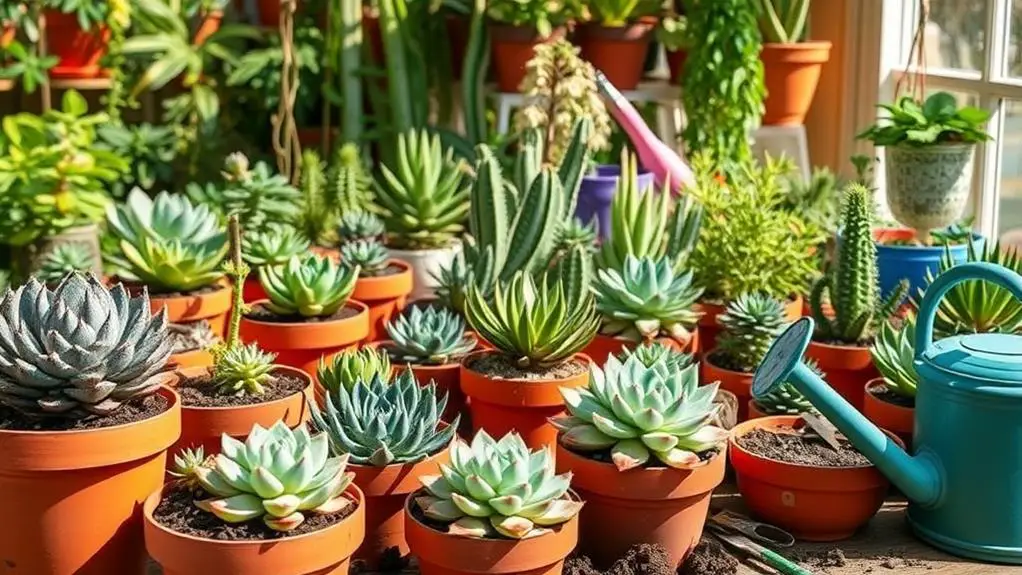
Gradual acclimatization to brighter sunlight is vital for hybrid succulents to avoid sunburn or stress.
Begin by placing your succulents in a shady spot and slowly move them to brighter areas over 1-2 weeks. This prevents shocking the plant with too much light too quickly.
When it comes to the care for hybrid succulents, using a gritty, well-draining soil mix is essential.
This type of soil guarantees water doesn't sit around the roots, which can cause rot. You can find specialized cactus or succulent soil at most garden centers.
Watering is another key factor. Hybrid succulents thrive when you water deeply but infrequently.
Wait until the soil is completely dry before watering again. This method mimics their natural environment and helps prevent overwatering. Always use containers with drainage holes to facilitate proper drainage.
During seasonal dormancy, which typically occurs in winter, keep your succulents dry.
They don't need much water during this period, and too much moisture can cause rot. Remember, each type of succulent might've slightly different needs, but these guidelines will help you care for most hybrids successfully.
Resources and Support
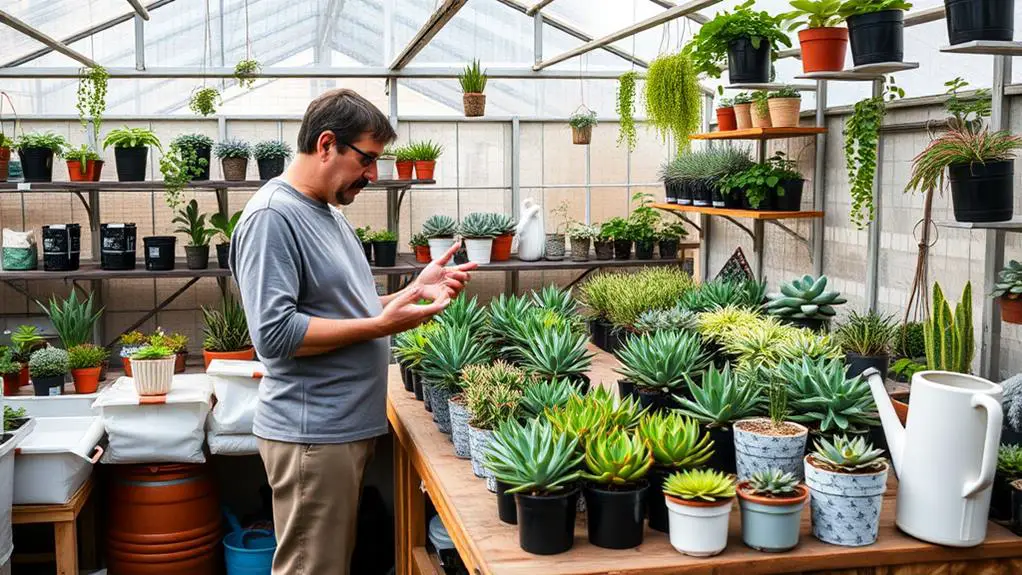
To successfully navigate the world of succulent hybridization, leverage a range of resources and support systems available to you. Start by exploring soil mixes and fertilizers specifically formulated for succulents. These products will promote healthy growth and increase your chances of hybridization success. Look for brands that cater to succulents' unique needs, ensuring they get the right nutrients.
Accessing succulent care guides is another essential step. These guides offer tailored instructions for different species and their hybrid counterparts, helping you understand the specific requirements of your plants. They're often available both online and in print, providing detailed, step-by-step advice.
Engage with community resources like forums and social media groups. These platforms are invaluable for sharing hybridization tips, experiences, and advice with fellow enthusiasts. You can ask questions, share your successes, and learn from others' mistakes.
Consider purchasing your succulents from specialized retailers known for quality assurance. These shops often carry unique varieties that aren't widely available, giving you more options for hybridization.
Don't hesitate to use customer support from gardening centers or online retailers. They can provide guidance on best practices for succulent care and hybridization, ensuring you have the support you need.
Frequently Asked Questions
How to Create Hybrid Succulents?
To create hybrid succulents, gather two compatible flowering succulents. Use a paintbrush or Q-tip to transfer pollen from the male to the female flower. Monitor for seed development and isolate the plant to guarantee successful hybridization.
How Do You Make Succulent Pups?
To make succulent pups, guarantee the parent plant is healthy with adequate sunlight, water, and well-draining soil. Once pups appear and grow to 2-4 inches, gently separate them, let them dry, and replant.
Do Succulents Multiply on Their Own?
Yes, succulents can multiply on their own. They use vegetative propagation, where new plants grow from leaves, stems, or offsets. You'll see pups or small clones form, which can be separated and replanted for new growth.
How Do You Know What Succulents Can Be Planted Together?
To know what succulents can be planted together, consider those in the same genus, like Echeveria and Graptopetalum. Check their flowering times and growing conditions. Research proven combinations in plant databases or gardening communities.
Conclusion
Creating succulent hybrids can be a fun and rewarding experience. You'll get to see unique plants grow and thrive under your care. Remember, patience and attention to detail are key. Don't rush the process, and make sure to provide the right environment for your hybrids. With dedication and a bit of effort, you'll soon enjoy the beauty of your own hybrid succulents. Immerse yourself, experiment, and most importantly, have fun with your gardening journey!

